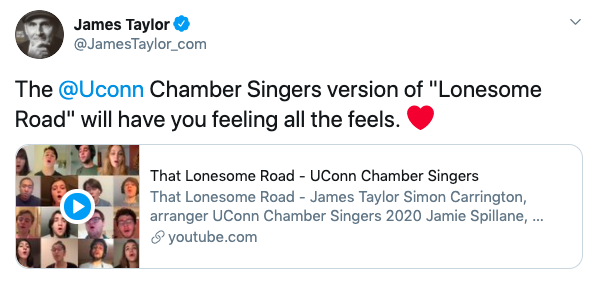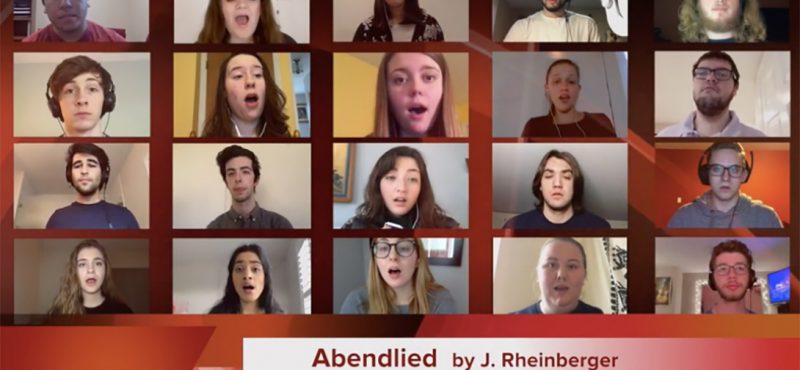Music-making is the ultimate communal activity. So when COVID-19 shuttered the giant campus at the University of Connecticut (UConn), Dr. Jamie Spillane, Director of Choral Studies, faced a serious challenge. In addition to his teaching duties, Spillane directs two ensembles: Chamber Singers, with 26 students, and the larger Concert Choir, with 105. “Choir is a bit like a sports team,” he says. “It’s about everyone working together to create excellence. We want to move people with our music, to put forth both the work of the composer and the emotion to the audience. How could we possibly do this when we’re all stuck at home?” Thanks to a strong dose of ingenuity and a broadband infrastructure that enabled him to stay connected to all of his students, Spillane was able to keep the music – and community – going strong. This is his story.
Tackling the Tech Curve
“We have a term called ‘cheerful flexibility’ that we use when the choir is on tour,” Spillane explains. “Unexpected things will always happen: a bus breaks down, or there is no changing room at the venue. If your mantra is ‘cheerful flexibility,’ it takes that kneejerk negative reaction away and opens you to more possibilities.” Applying that motto to the pandemic opened both professor and students to trying new things – which began with tackling a learning curve of technology.
For their first digital piece, James Taylor’s folk song, “That Lonesome Road,” each member of the Chamber Choir recorded their individual part and sent it to Spillane, who then spent 25 hours compiling the tracks using Logic Pro. “The magic of the technology lines up the recordings, fixes people’s consonants, and makes sure the melody comes out,” says Spillane. “And the students only needed a smartphone in order to record themselves. That way, it was accessible to everyone.” The choir’s hard work was rewarded when James Taylor himself tweeted the arrangement with the message, “The @UConn Chamber Singers version of “Lonesome Road” will have you feeling all the feels.”

The test run proved crucial for the Chamber Choir’s next piece, Abendlied. Thanks to their experience, the students were better at recording and Spillane was faster at mixing. The result was a recording that went on to be featured on the choral music platform Choirbuzz and by the international a cappella group Voces8, which chose it as their “virtual choir pick of the week.” Between the two platforms, the song collected over 20,000 views. “When in a regular concert do you ever reach 20,000 people?” Spillane asks. “You just don’t. So this whole experience – it’s imperfect. But it’s something different. And it’s wonderful in its own way.” Thanks to a combination of connectivity, software, and social media promotion, the Chamber Choir was able to reach an audience way beyond the concert hall.
Maintaining Community
For the larger Concert Choir, the sheer number of students precluded creating digital music as easily. The challenge for this group became: how to keep 105 students connected and learning through the crisis? To this end, Spillane set up a weekly Zoom call for members to share their work and experiences. Thanks to reliable high-speed internet, 99% of Spillane’s students had no problems logging in and streaming video, and “managing a hundred students on the video call was not bad at all,” he says. “There’s a chat portion and they can ask questions on there. In fact, I’ve found students are more likely to ask questions on Zoom than they would have before. It’s less intimidating.”
Leveraging the internet also allowed the group to meet with guest speakers from the world of choral music. “We met with Norwegian composer Ola Gjeilo on Zoom,” says Spillane. “He took questions and students got to interact with him. That was very cool because we’ve done a fair amount of his music. The students were very excited – and it wouldn’t have happened in-person.”
“Cheerful flexibility” has also come into play when it comes to grading student work. Normally, grades are based upon attendance, participation, and singing – with graduate students dividing the students into smaller groups to ensure they’d mastered their parts. Unable to sing together as a group, Spillane generated a list of 18 different assignments that students could choose from. These ranged from singing arrangements onto an app, to recording original music on Garage Band or Logic Pro, to discovering new musicians on the podcast Song Exploder. “They had to submit an assignment every 8 days,” says Spillane, “which meant I was going through 105 separate assignments every 8 days. It took time, but it also offered such incredible insights into these students. And they created so much wonderful content! I feel very lucky.”
Incorporating Innovation in the Future
It’s unclear what the fall semester will look like: a complete reopening, distance learning, or a hybrid. But one thing Spillane is certain of is that he will continue to incorporate his new innovations – even when his choirs meet in-person again. “It’s been a fascinating process for me; I can’t say enough about it,” he says. “I feel like I gained more skills in ways that would not have happened otherwise.” While nothing can take the place of making music together and performing for a live audience, the power of the internet and technology has enabled Spillane and his students to continue to learn and connect and make art – something that would have been impossible only a few decades ago.
